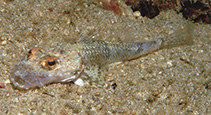| Family: |
Platycephalidae (Flatheads) |
| Max. size: |
11 cm TL (male/unsexed) |
| Environment: |
demersal; marine; depth range 15 - 110 m, non-migratory |
| Distribution: |
Indo-West Pacific: widespread, from off Natal, South Africa to Karachi, Maldives, South China Sea, Philippines, Irian Barat (Teluk Berau), Northwest Shelf of Australia, Timor and Arafura seas, Great Barrier Reef, Guadalcanal and Tonga. |
| Diagnosis: |
Dorsal spines (total): 9-9; Dorsal soft rays (total): 11-11; Anal spines: 0-0; Anal soft rays: 10-11. No supraocular cirrus present. Infraorbital ridge entirely serrated over eye. Preopercular spines 3-5, slanting towards midline. Suborbital ridge with no smooth notch under eye. Antorbital margin with 2 antrorse spines. Lower side of head unicarinate. Lateral line scales frequently 30 or 31, anterior 2-6 (frequently 3) scales bearing spines. Iris lappet bilobed or crenate. Upper surface of eye smooth, no cirrus present. Pelvic fin with a prominent dark blotch in middle, a smaller dark blotch near base.
Description: Characterized by mottled grey brown color; 4-6 brown or olive dark bands across back and side; anterior caudal peduncle with slightly forward slanting band; base of caudal fin with narrow band; brown spots and mottling on fins (Ref. 90102). |
| Biology: |
Taken by trawl over sand or coral rubble bottom at 15 to 110 m; also taken by SCUBA off coral or rocky slopes (Ref. 9790). Occurs near reefs (Ref 90102). |
| IUCN Red List Status: |
Least Concern (LC); Date assessed: 04 March 2015 Ref. (130435)
|
| Threat to humans: |
harmless |
Source and more info: www.fishbase.org. For personal, classroom, and other internal use only. Not for publication.

